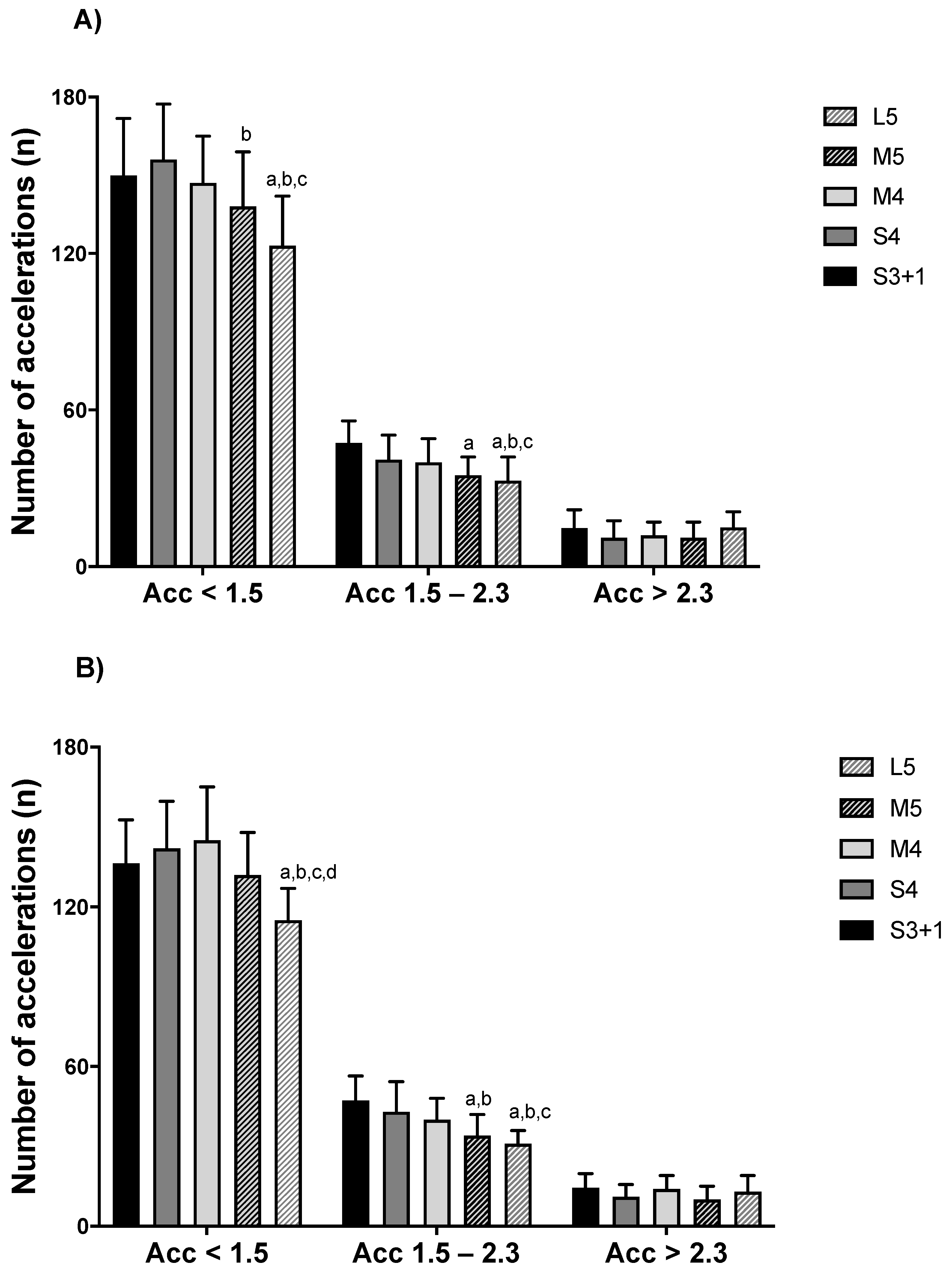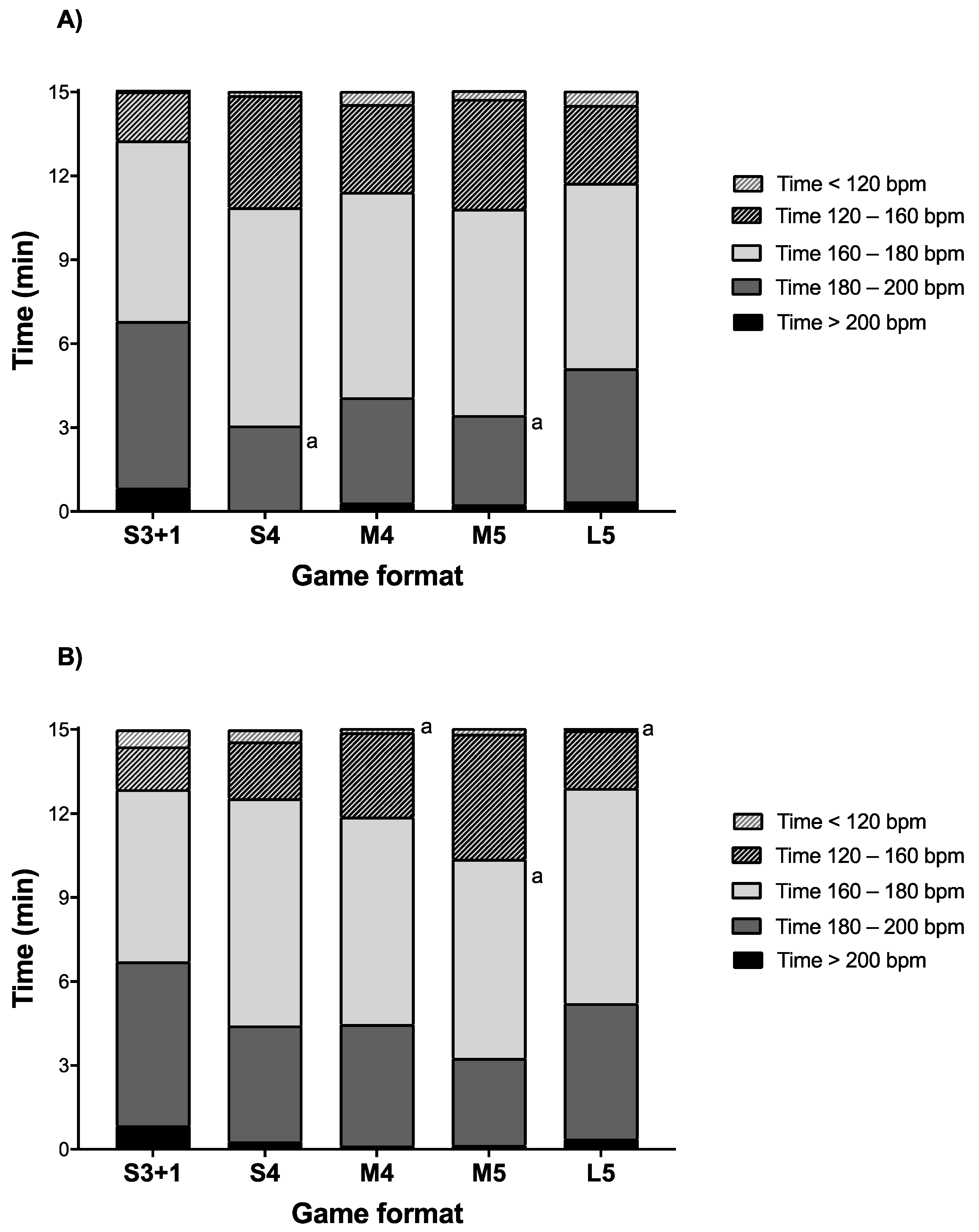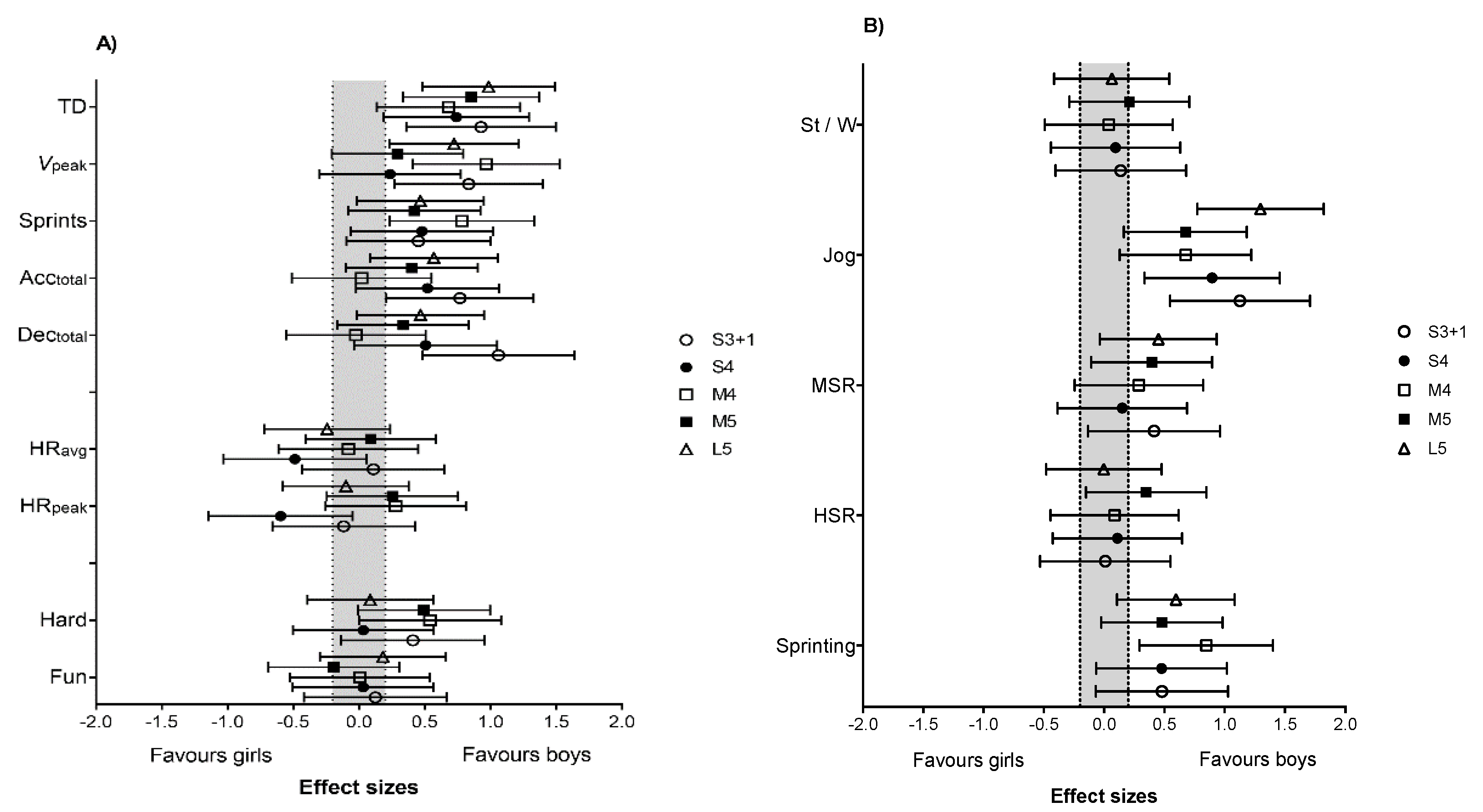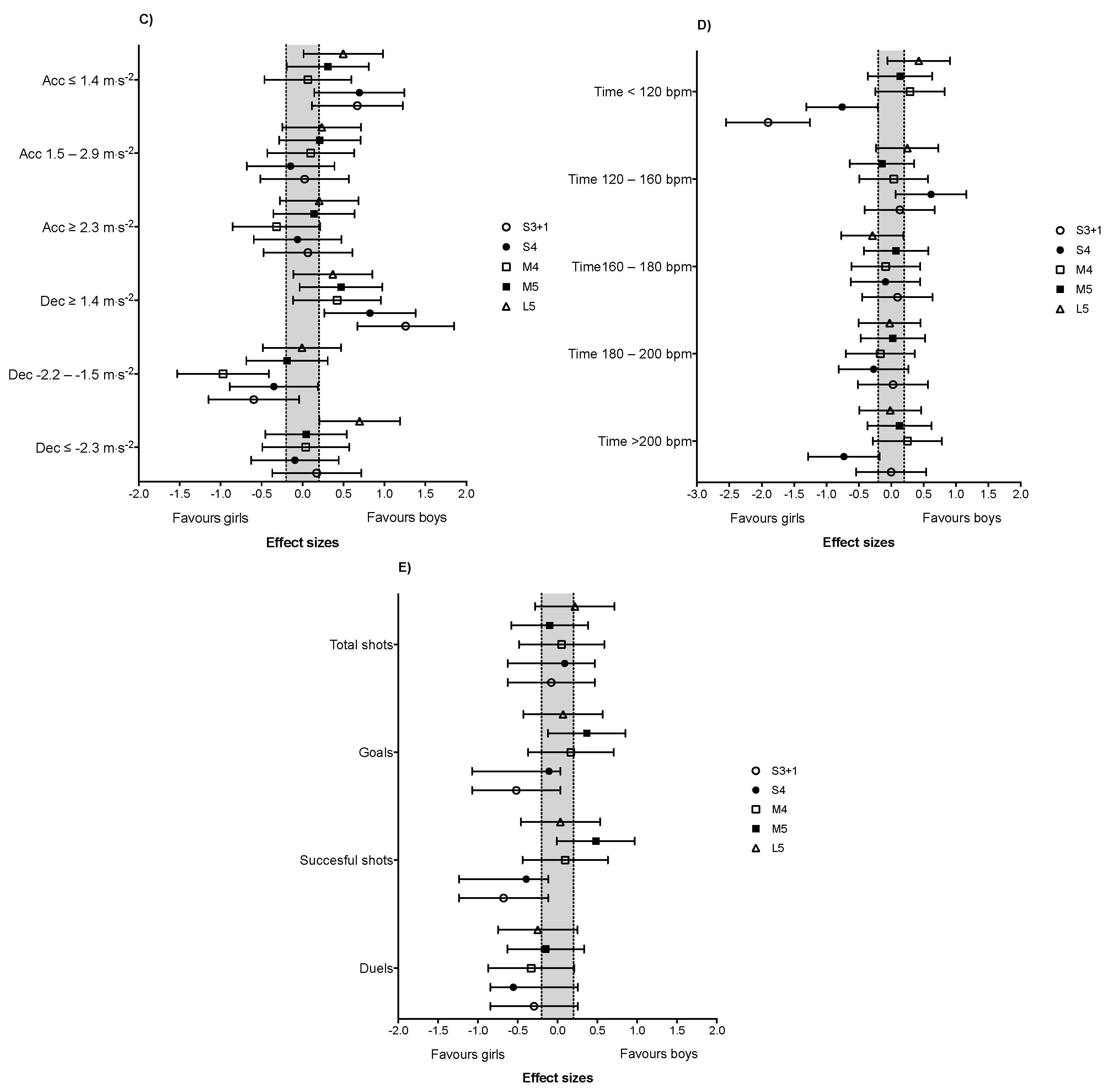Exercise Intensity and Technical Involvement in U9 Team Handball: Effect of Game Format
Abstract
1. Introduction
2. Materials and Methods
2.1. Design
- (S3 + 1): 3 vs. 3 + offensive goalkeepers on a small size pitch size of 20 × 13 m (37 m2 per player);
- (S4): 4 vs. 4 on a small size (33 m2 per player);
- (M4): 4 vs. 4 on a medium size pitch size of 25.8 × 20 m (65 m2 per player);
- (M5): 5 vs. 5 on a medium size (52 m2 per player);
- (L5): 5 vs. 5 on a large size pitch size of 40 × 20 m (80 m2 per player).
2.2. Participants
2.3. Activity Profile
2.4. Heart Rate and Subjective Perceptions
2.5. Technical Analysis
2.6. Statistical Analyses
3. Results
3.1. Activity Profile
3.2. Heart Rate and Subjective Perceptions
3.3. Technical Analysis
3.4. Gender
4. Discussion
5. Conclusions
Author Contributions
Funding
Institutional Review Board Statement
Informed Consent Statement
Conflicts of Interest
References
- Gorostiaga, E.M.; Granados, C.; Ibanez, J.; Izquierdo, M. Differences in physical fitness and throwing velocity among elite and amateur male handball players. Int. J. Sports Med. 2005, 26, 225–232. [Google Scholar] [CrossRef]
- Povoas, S.C.; Seabra, A.F.; Ascensao, A.A.; Magalhaes, J.; Soares, J.M.; Rebelo, A.N. Physical and physiological demands of elite team handball. J. Strength Cond. Res. 2012, 26, 3365–3375. [Google Scholar] [CrossRef]
- Michalsik, L.B.; Madsen, K.; Aagaard, P. Match performance and physiological capacity of female elite team handball players. Int. J. Sports Med. 2014, 35, 595–607. [Google Scholar] [CrossRef] [PubMed]
- Chelly, M.S.; Hermassi, S.; Aouadi, R.; Khalifa, R.; Van den Tillaar, R.; Chamari, K.; Shephard, R.J. Match analysis of elite adolescent team handball players. J. Strength Cond. Res. 2011, 25, 2410–2417. [Google Scholar] [CrossRef] [PubMed]
- Souhail, H.; Castagna, C.; Mohamed, H.Y.; Younes, H.; Chamari, K. Direct validity of the yo-yo intermittent recovery test in young team handball players. J. Strength Cond. Res. 2010, 24, 465–470. [Google Scholar] [CrossRef] [PubMed]
- Madsen, M.; Ermidis, G.; Rago, V.; Surrow, K.; Vigh-Larsen, J.F.; Randers, M.B.; Krustrup, P.; Larsen, M.N. Activity Profile, Heart Rate, Technical Involvement, and Perceived Intensity and Fun in U13 Male and Female Team Handball Players: Effect of Game Format. Sports 2019, 7, 90. [Google Scholar] [CrossRef]
- Randers, M.B.; Andersen, T.B.; Rasmussen, L.S.; Larsen, M.N.; Krustrup, P. Effect of game format on heart rate, activity profile, and player involvement in elite and recreational youth players. Scand. J. Med. Sci. Sports 2014, 24 (Suppl. 1), 17–26. [Google Scholar] [CrossRef] [PubMed]
- Halouani, J.; Chtourou, H.; Gabbett, T.; Chaouachi, A.; Chamari, K. Small-sided games in team sports training: A brief review. J. Strength Cond. Res. 2014, 28, 3594–3618. [Google Scholar] [CrossRef]
- Aroso, J.; Rebelo, A.; Gomes-Pereira, J. Physiological impact of selected game-related exercises. J. Sports Sci. 2004, 22, 522. [Google Scholar]
- Owen, A.L.; Wong del, P.; McKenna, M.; Dellal, A. Heart rate responses and technical comparison between small- vs. large-sided games in elite professional soccer. J. Strength Cond. Res. 2011, 25, 2104–2110. [Google Scholar] [CrossRef]
- Malina, R.M.; Eisenmann, J.C.; Cumming, S.P.; Ribeiro, B.; Aroso, J. Maturity-associated variation in the growth and functional capacities of youth football (soccer) players 13–15 years. Eur. J. Appl. Physiol. 2004, 91, 555–562. [Google Scholar] [CrossRef]
- Malina, R.M.C.; Bar-Or, O. Growth, Maturation, and Physical Activity, 2nd ed.; Human Kinetics: Champaign, IL, USA, 2004. [Google Scholar]
- Hill-Haas, S.V.; Rowsell, G.J.; Dawson, B.T.; Coutts, A.J. Acute physiological responses and time-motion characteristics of two small-sided training regimes in youth soccer players. J. Strength Cond. Res. 2009, 23, 111–115. [Google Scholar] [CrossRef] [PubMed]
- Barbero-Alvarez, J.C.; Gomez-Lopez, M.; Castagna, C.; Barbero-Alvarez, V.; Romero, D.V.; Blanchfield, A.W.; Nakamura, F.Y. Game Demands of Seven-A-Side Soccer in Young Players. J. Strength Cond. Res. 2017, 31, 1771–1779. [Google Scholar] [CrossRef]
- Sanchez-Sanchez, J.; Sanchez, M.; Hernandez, D.; Ramirez-Campillo, R.; Martinez, C.; Nakamura, F.Y. Fatigue In U12 Soccer-7 Players During Repeated One-Day Tournament Games—A Pilot Study. J. Strength Cond. Res. 2017, 33, 3092–3097. [Google Scholar] [CrossRef]
- Akyildiz, Z.; Yildiz, M.; Clemente, F.M. The reliability and accuracy of Polar Team Pro GPS units. Proc. Inst. Mech. Eng. Part P J. Sports Eng. Technol. 2020, 1754337120976660. [Google Scholar] [CrossRef]
- Rebelo, A.; Brito, J.; Seabra, A.; Oliveira, J.; Drust, B.; Krustrup, P. A new tool to measure training load in soccer training and match play. Int. J. Sports Med. 2012, 33, 297–304. [Google Scholar] [CrossRef] [PubMed]
- Wewers, M.E.; Lowe, N.K. A critical review of visual analogue scales in the measurement of clinical phenomena. Res. Nurs. Health 1990, 13, 227–236. [Google Scholar] [CrossRef]
- Liu, H.; Gomez, M.-Á.; Lago-Peñas, C.; Sampaio, J. Match statistics related to winning in the group stage of 2014 Brazil FIFA World Cup. J. Sports Sci. 2015, 33, 1205–1213. [Google Scholar] [CrossRef] [PubMed]
- Michalsik, L.B.; Madsen, K.; Aagaard, P. Technical match characteristics and influence of body anthropometry on playing performance in male elite team handball. J. Strength Cond. Res. 2015, 29, 416–428. [Google Scholar] [CrossRef]
- Cnaan, A.; Laird, N.M.; Slasor, P. Using the general linear mixed model to analyse unbalanced repeated measures and longitudinal data. Stat. Med. 1997, 16, 2349–2380. [Google Scholar] [CrossRef]
- Hopkins, W.G.; Marshall, S.W.; Batterham, A.M.; Hanin, J. Progressive statistics for studies in sports medicine and exercise science. Med. Sci. Sports Exerc. 2009, 41, 3–13. [Google Scholar] [CrossRef]
- Batterham, A.M.; Hopkins, W.G. Making meaningful inferences about magnitudes. Int. J. Sports Physiol. Perform. 2006, 1, 50–57. [Google Scholar] [CrossRef]
- Hopkins, W. A spreadsheet for deriving a confidence interval, mechanistic inference and clinical inference from a P value. Sportscience 2007, 11, 16–21. [Google Scholar]
- Casamichana, D.; Castellano, J. Time-motion, heart rate, perceptual and motor behaviour demands in small-sides soccer games: Effects of pitch size. J. Sports Sci 2010, 28, 1615–1623. [Google Scholar] [CrossRef] [PubMed]
- Missawi, K.; Zouch, M.; Chakroun, Y.; Chaari, H.; Tabka, Z.; Bouajina, E. Handball Practice Enhances Bone Mass in Specific Sites Among Prepubescent Boys. J. Clin. Densitom. 2016, 19, 389–395. [Google Scholar] [CrossRef] [PubMed]
- Seabra, A.; Marques, E.; Brito, J.; Krustrup, P.; Abreu, S.; Oliveira, J.; Rego, C.; Mota, J.; Rebelo, A. Muscle strength and soccer practice as major determinants of bone mineral density in adolescents. Jt. Bone Spine 2012, 79, 403–408. [Google Scholar] [CrossRef] [PubMed]
- Vicente-Rodriguez, G.; Ara, I.; Perez-Gomez, J.; Dorado, C.; Calbet, J.A. Muscular development and physical activity as major determinants of femoral bone mass acquisition during growth. Br. J. Sports Med. 2005, 39, 611–616. [Google Scholar] [CrossRef]
- Larsen, M.N.; Nielsen, C.M.; Helge, E.W.; Madsen, M.; Manniche, V.; Hansen, L.; Hansen, P.R.; Bangsbo, J.; Krustrup, P. Positive effects on bone mineralisation and muscular fitness after 10 months of intense school-based physical training for children aged 8–10 years: The FIT FIRST randomised controlled trial. Br. J. Sports Med. 2018, 52, 254. [Google Scholar] [CrossRef]
- Larsen, M.N.; Nielsen, C.M.; Madsen, M.; Manniche, V.; Hansen, L.; Bangsbo, J.; Krustrup, P.; Hansen, P.R. Cardiovascular adaptations after 10 months of intense school-based physical training for 8- to 10-year-old children. Scand. J. Med. Sci. Sports 2018, 28 (Suppl. 1), 33–41. [Google Scholar] [CrossRef]
- Helgerud, J.; Hoydal, K.; Wang, E.; Karlsen, T.; Berg, P.; Bjerkaas, M.; Simonsen, T.; Helgesen, C.; Hjorth, N.; Bach, R.; et al. Aerobic high-intensity intervals improve VO2max more than moderate training. Med. Sci. Sports Exerc. 2007, 39, 665–671. [Google Scholar] [CrossRef]
- Nybo, L.; Sundstrup, E.; Jakobsen, M.D.; Mohr, M.; Hornstrup, T.; Simonsen, L.; Bulow, J.; Randers, M.B.; Nielsen, J.J.; Aagaard, P.; et al. High-intensity training versus traditional exercise interventions for promoting health. Med. Sci. Sports Exerc. 2010, 42, 1951–1958. [Google Scholar] [CrossRef] [PubMed]
- Archer, E.; Blair, S.N. Physical activity and the prevention of cardiovascular disease: From evolution to epidemiology. Prog. Cardiovasc. Dis. 2011, 53, 387–396. [Google Scholar] [CrossRef] [PubMed]
- Bendiksen, M.; Williams, C.A.; Hornstrup, T.; Clausen, H.; Kloppenborg, J.; Shumikhin, D.; Brito, J.; Horton, J.; Barene, S.; Jackman, S.R.; et al. Heart rate response and fitness effects of various types of physical education for 8- to 9-year-old schoolchildren. Eur. J. Sport Sci. 2014, 14, 861–869. [Google Scholar] [CrossRef] [PubMed]
- Sperlich, B.; Zinner, C.; Heilemann, I.; Kjendlie, P.L.; Holmberg, H.C.; Mester, J. High-intensity interval training improves VO(2peak), maximal lactate accumulation, time trial and competition performance in 9–11-year-old swimmers. Eur. J. Appl. Physiol. 2010, 110, 1029–1036. [Google Scholar] [CrossRef] [PubMed]
- Corvino, M.; Tessitore, A.; Minganti, C.; Sibila, M. Effect of Court Dimensions on Players’ External and Internal Load during Small-Sided Handball Games. J. Sports Sci. Med. 2014, 13, 297–303. [Google Scholar]
- Abrantes, C.I.; Nunes, M.I.; Maçãs, V.M.; Leite, N.M.; Sampaio, J.E. Effects of the number of players and game type constraints on heart rate, rating of perceived exertion, and technical actions of small-sided soccer games. J. Strength Cond. Res. 2012, 26, 976–981. [Google Scholar] [CrossRef]
- Bangsbo, J.; Krustrup, P.; Duda, J.; Hillman, C.; Andersen, L.B.; Weiss, M.; Williams, C.A.; Lintunen, T.; Green, K.; Hansen, P.R.; et al. The Copenhagen Consensus Conference 2016: Children, youth, and physical activity in schools and during leisure time. Br. J. Sports Med. 2016, 50, 1177–1178. [Google Scholar] [CrossRef]
- O’Connor, D.; Gardner, L.; Larkin, P.; Pope, A.; Williams, A.M. Positive youth development and gender differences in high performance sport. J. Sports Sci 2020, 38, 1399–1407. [Google Scholar] [CrossRef]
- Mendez-Villanueva, A.; Buchheit, M.; Simpson, B.; Bourdon, P.C. Match play intensity distribution in youth soccer. Int. J. Sports Med. 2013, 34, 101–110. [Google Scholar] [CrossRef]






| Variables (U9) | Sex | S3 + 1 | S4 | M4 | M5 | L5 |
|---|---|---|---|---|---|---|
| Activity profile | ||||||
| TD (m) | Boys | 1133 ± 171 | 988 ± 141 | 1106 ± 157 | 977 ± 172 a | 1320 ± 232 a,b,c,d |
| Girls | 965 ± 195 | 878 ± 159 | 999 ± 156 | 846 ± 124 c | 1125 ± 134 a,b,d | |
| Vpeak (km·h−1) | Boys | 21.4 ± 3.2 | 20.1 ± 3.0 | 22.4 ± 3.1 | 20.7 ± 2.8 | 23.6 ± 3.0 b,d |
| Girls | 19.0 ± 2.3 | 19.5 ± 2.6 | 19.5 ± 2.8 | 19.9 ± 2.7 | 21.6 ± 2.4 a | |
| Sprints (counts) | Boys | 5.1 ± 5.4 | 2.9 ± 3.6 | 5.8 ± 5.2 | 4.6 ± 5.5 | 11.9 ± 7.5 a,b,c,d |
| Girls | 2.9 ± 3.5 | 1.5 ± 1.5 | 2.4 ± 2.6 | 2.7 ± 2.5 | 8.4 ± 7.6 a,b,c,d | |
| Acctotal (counts) | Boys | 212.0 ± 20.3 | 209.0 ± 21.2 | 200.7 ± 20.0 | 186.1 ± 21.6 a,b | 172.2 ± 23.2 a,b,c,d |
| Girls | 198.0 ± 14.4 | 197.1 ± 25.3 | 200.3 ± 21.4 | 177.4 ± 21.7 a,b,c | 160.7 ± 15.0 a,b,c,d | |
| Dectotal (counts) | Boys | 219.8 ± 17.3 | 209.8 ± 21.7 | 203.6 ± 17.8 | 191.5 ± 19.7 a,b,c | 182.7 ± 24.0 a,b,d |
| Girls | 201.1 ± 18.1 | 197.1 ± 26.4 | 204.1 ± 17.8 | 184.7 ± 20.9 a,b,c | 173.2 ± 13.6 a,b,d | |
| Heart rate | ||||||
| HRavg (bpm) | Boys | 175.8 ± 10.3 | 165.9 ± 11.2 | 167.9 ± 11.5 | 165.8 ± 13.1 | 169.7 ± 14.8 |
| Girls | 174.7 ± 10.2 | 171.1 ± 9.7 | 168.8 ± 11.1 | 164.6 ± 13.5 | 172.8 ± 8.7 | |
| HRpeak (bpm) | Boys | 195.1 ± 10.3 | 185.6 ± 10.1 a | 192.3 ± 10.5 | 189.2 ± 11.6 | 191.2 ± 11.1 |
| Girls | 196.3 ± 8.6 | 191.9 ± 11.4 | 189.4 ± 9.5 | 186.1 ± 12.8 | 192.3 ± 8.3 | |
| Subjective perceptions | ||||||
| RPE (AU) | Boys | 8.4 ± 3.8 | 10.2 ± 4.2 | 8.5 ± 4.1 | 9.2 ± 5.2 | 6.9 ± 4.9 |
| Girls | 6.9 ± 3.3 | 10.1 ± 3.0 | 6.4 ± 3.3 | 6.8 ± 4.4 | 6.5 ± 4.8 | |
| RPF (AU) | Boys | 4.3 ± 4.6 | 5.2 ± 4.7 | 5.2 ± 4.3 | 4.5 ± 5.1 | 5.0 ± 5.4 |
| Girls | 3.8 ± 2.7 | 5.0 ± 3.7 | 5.1 ± 2.8 | 5.4 ± 3.6 | 4.1 ± 4.7 |
| Variables | Sex | S3 + 1 | S4 | M4 | M5 | L5 |
|---|---|---|---|---|---|---|
| Shots (counts) | Boys | 7.0 ± 4.1 | 6.4 ± 3.9 | 4.9 ± 3.3 | 3.5 ± 2.6 a,b | 3.2 ± 2.1 a,b |
| Girls | 7.4 ± 3.5 | 6.0 ± 5.2 | 4.7 ± 2.8 | 3.8 ± 3.0 a | 2.8 ± 2.0 a | |
| Goals (counts) | Boys | 2.5 ± 2.4 | 2.2 ± 2.1 | 2.0 ± 2.0 | 1.1 ± 1.3 | 1.1 ± 1.0 |
| Girls | 3.9 ± 2.9 | 2.4 ± 1.5 | 1.6 ± 1.4 a | 0.7 ± 0.9 b | 1.0 ± 1.3 a | |
| Successful shots (counts) | Boys | 35.2 ± 29.2 | 34.7 ± 23.9 | 38.0 ± 30.1 | 29.2 ± 32.0 | 32.2 ± 28.9 |
| Girls | 53.7 ± 23.9 | 47.4 ± 41.3 | 35.3 ± 25.8 | 15.4 ± 22.5 a,b | 31.0 ± 38.9 | |
| Duels (counts) | Boys | 1.1 ± 1.2 | 0.7 ± 1.3 | 0.7 ± 1.1 | 0.5 ± 0.9 | 0.4 ± 0.6 |
| Girls | 1.7 ± 2.8 | 1.6 ± 2.1 | 1.2 ± 1.7 | 0.6 ± 1.0 | 0.6 ± 1.2 |
Publisher’s Note: MDPI stays neutral with regard to jurisdictional claims in published maps and institutional affiliations. |
© 2021 by the authors. Licensee MDPI, Basel, Switzerland. This article is an open access article distributed under the terms and conditions of the Creative Commons Attribution (CC BY) license (https://creativecommons.org/licenses/by/4.0/).
Share and Cite
Ermidis, G.; Ellegard, R.C.; Rago, V.; Randers, M.B.; Krustrup, P.; Larsen, M.N. Exercise Intensity and Technical Involvement in U9 Team Handball: Effect of Game Format. Int. J. Environ. Res. Public Health 2021, 18, 5663. https://doi.org/10.3390/ijerph18115663
Ermidis G, Ellegard RC, Rago V, Randers MB, Krustrup P, Larsen MN. Exercise Intensity and Technical Involvement in U9 Team Handball: Effect of Game Format. International Journal of Environmental Research and Public Health. 2021; 18(11):5663. https://doi.org/10.3390/ijerph18115663
Chicago/Turabian StyleErmidis, Georgios, Rasmus C. Ellegard, Vincenzo Rago, Morten B. Randers, Peter Krustrup, and Malte N. Larsen. 2021. "Exercise Intensity and Technical Involvement in U9 Team Handball: Effect of Game Format" International Journal of Environmental Research and Public Health 18, no. 11: 5663. https://doi.org/10.3390/ijerph18115663
APA StyleErmidis, G., Ellegard, R. C., Rago, V., Randers, M. B., Krustrup, P., & Larsen, M. N. (2021). Exercise Intensity and Technical Involvement in U9 Team Handball: Effect of Game Format. International Journal of Environmental Research and Public Health, 18(11), 5663. https://doi.org/10.3390/ijerph18115663







